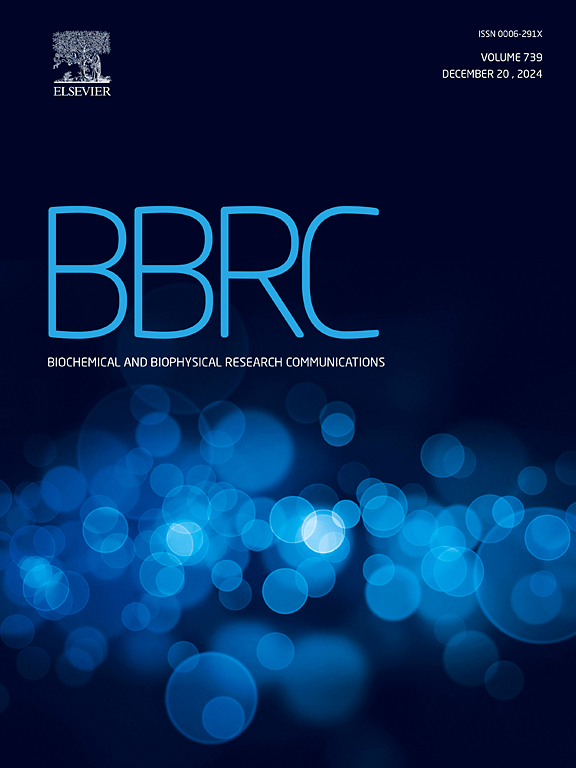Deciphering the transcriptomic characteristic of lactate metabolism and the immune infiltration landscape in abdominal aortic aneurysm
IF 2.2
3区 生物学
Q3 BIOCHEMISTRY & MOLECULAR BIOLOGY
Biochemical and biophysical research communications
Pub Date : 2025-06-14
DOI:10.1016/j.bbrc.2025.152198
引用次数: 0
Abstract
Background
Abdominal aortic aneurysm (AAA) is a common degenerative vascular disease characterized by progressive dilation of the abdominal aorta, which poses a life-threatening risk upon rupture. Lactate, a key metabolic byproduct and immunomodulatory molecule, plays a crucial role in regulating immune cell functions in various inflammatory diseases. However, the specific involvement of lactate metabolism in the pathogenesis of AAA remains poorly understood. This study aims to identify lactate metabolism-related gene signatures associated with AAA and to elucidate their potential roles and underlying mechanisms in disease progression.
Methods
Transcriptomic datasets GSE57691, GSE183464, and GSE237230 were obtained from the Gene Expression Omnibus (GEO) database. Lactate metabolism-related genes were retrieved from the Molecular Signatures Database (MSigDB). Weighted Gene Co-expression Network Analysis (WGCNA) and the Limma R package were employed to identify key gene modules associated with AAA and detect differentially expressed genes (DEGs) between AAA and control groups, respectively. Overlapping genes were subjected to functional enrichment analysis and protein–protein interaction (PPI) network construction. Three distinct machine learning algorithms were applied to screen for potential diagnostic biomarkers. Upon validation, a nomogram was constructed based on the selected biomarkers. Immune infiltration and single-cell RNA analysis were performed to characterize the immune microenvironment and investigate the association between immune cell subsets and AAA-related biomarkers. Finally, the expression patterns of the identified biomarkers were validated using a murine model of AAA.
Results
A total of 3336 AAA-related module genes, 2651 DEGs between AAA and controls, and 364 lactate metabolism-related genes were identified. Among these, 29 genes were recognized as lactate metabolism-related DEGs associated with AAA. Functional enrichment analysis revealed significant enrichment in pathways related to oxidative phosphorylation and energy metabolism. SLC25A4, HBB, and STAT4 were identified as candidate biomarkers for AAA. Immune infiltration analysis revealed distinct immune profiles between AAA and control groups. Single-cell mRNA analysis demonstrated that SLC25A4 is predominantly expressed in adventitial cells and fibroblasts in AAA, HBB is expressed across multiple immune cell subsets, and STAT4 is mainly expressed in T cells. Gene Set Enrichment Analysis indicated that these biomarkers are involved in biological processes related to T cell activation and T cell differentiation. These findings were further validated in a murine model of AAA.
Conclusions
The identification of lactate metabolism-related biomarkers and the comprehensive characterization of the immune microenvironment in AAA offer novel insights that may contribute to the development of targeted therapeutic strategies for AAA.
解读腹主动脉瘤乳酸代谢的转录组学特征及免疫浸润景观
腹主动脉瘤(AAA)是一种常见的退行性血管疾病,其特征是腹主动脉进行性扩张,一旦破裂会危及生命。乳酸是一种重要的代谢副产物和免疫调节分子,在各种炎症疾病中对免疫细胞功能的调节起着至关重要的作用。然而,乳酸代谢在AAA发病机制中的具体作用仍知之甚少。本研究旨在确定与AAA相关的乳酸代谢相关基因特征,并阐明其在疾病进展中的潜在作用和潜在机制。方法从Gene Expression Omnibus (GEO)数据库中获取转录组数据集GSE57691、GSE183464和GSE237230。从分子特征数据库(MSigDB)中检索乳酸代谢相关基因。采用加权基因共表达网络分析(Weighted Gene Co-expression Network Analysis, WGCNA)和Limma R软件包分别鉴定与AAA相关的关键基因模块,并检测AAA组与对照组之间的差异表达基因(differential expression genes, DEGs)。对重叠基因进行功能富集分析和蛋白相互作用(PPI)网络构建。三种不同的机器学习算法应用于筛选潜在的诊断性生物标志物。验证后,根据选定的生物标志物构建nomogram。通过免疫浸润和单细胞RNA分析来表征免疫微环境,并研究免疫细胞亚群与aaa相关生物标志物之间的关系。结果共鉴定出3336个与AAA相关的模块基因,其中AAA与对照组之间的差异基因2651个,乳酸代谢相关基因364个。其中,29个基因被认为是与AAA相关的乳酸代谢相关的deg。功能富集分析显示,氧化磷酸化和能量代谢相关通路显著富集。SLC25A4、HBB和STAT4被确定为AAA的候选生物标志物。免疫浸润分析显示AAA组和对照组之间存在明显的免疫特征。单细胞mRNA分析表明,SLC25A4主要表达于AAA的上皮细胞和成纤维细胞中,HBB在多个免疫细胞亚群中表达,STAT4主要表达于T细胞中。基因集富集分析表明,这些生物标志物参与了与T细胞活化和T细胞分化相关的生物学过程。结论乳酸代谢相关生物标志物的鉴定和AAA免疫微环境的全面表征为AAA靶向治疗策略的开发提供了新的见解。
本文章由计算机程序翻译,如有差异,请以英文原文为准。
求助全文
约1分钟内获得全文
求助全文
来源期刊
CiteScore
6.10
自引率
0.00%
发文量
1400
审稿时长
14 days
期刊介绍:
Biochemical and Biophysical Research Communications is the premier international journal devoted to the very rapid dissemination of timely and significant experimental results in diverse fields of biological research. The development of the "Breakthroughs and Views" section brings the minireview format to the journal, and issues often contain collections of special interest manuscripts. BBRC is published weekly (52 issues/year).Research Areas now include: Biochemistry; biophysics; cell biology; developmental biology; immunology
; molecular biology; neurobiology; plant biology and proteomics

 求助内容:
求助内容: 应助结果提醒方式:
应助结果提醒方式:


